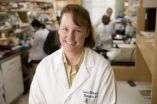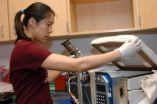(Press-News.org) The question seems simple enough: What happens to the Earth's temperature when atmospheric carbon dioxide levels increase? The answer is elusive. However, clues are hidden in the fossil record. A new study by researchers from Syracuse and Yale universities provides a much clearer picture of the Earth's temperature approximately 50 million years ago when CO2 concentrations were higher than today. The results may shed light on what to expect in the future if CO2 levels keep rising.
The study, which for the first time compared multiple geochemical and temperature proxies to determine mean annual and seasonal temperatures, is published online in the journal Geology, the premier publication of the Geological Society of America, and is forthcoming in print Aug. 1.
SU Alumnus Caitlin Keating-Bitonti '09 is the corresponding author of the study. She conducted the research as an undergraduate student under the guidance of Linda Ivany, associate professor of earth sciences, and Scott Samson, professor of earth sciences, both in Syracuse University's College of Arts and Sciences. Early results led the team to bring in Hagit Affek, assistant professor of geology and geophysics at Yale University, and Yale Ph.D. candidate Peter Douglas for collaborative study. The National Science Foundation and the American Chemical Society funded the research.
"The early Eocene Epoch (50 million years ago) was about as warm as the Earth has been over the past 65 million years, since the extinction of the dinosaurs," Ivany says. "There were crocodiles above the Arctic Circle and palm trees in Alaska. The questions we are trying to answer are how much warmer was it at different latitudes and how can that information be used to project future temperatures based on what we know about CO2 levels?"
Previous studies have suggested that the polar regions (high-latitude areas) during the Eocene were very hot—greater than 30 degrees centigrade (86 degrees Fahrenheit). However, because the sun's rays are strongest at the Earth's equator, tropical and subtropical areas (lower latitude) will always be at least as warm as polar areas, if not hotter. Until now, temperature data for subtropical regions were limited.
The SU and Yale research team found that average Eocene water temperature along the subtropical U.S. Gulf Coast hovered around 27 degrees centigrade (80 degrees Fahrenheit), slightly cooler than earlier studies predicted. Modern temperatures in the study area average 75 degrees Fahrenheit. Additionally, the scientists discovered that, during the Eocene, temperatures in the study area did not change more than 3 to 5 degrees centigrade across seasons, whereas today, the area's seasonal temperatures fluctuate by 12 degrees centigrade. The new results indicate that the polar and sub-polar regions, while still very warm, could not have been quite as hot as previously suggested.
The findings are based on a chemical analysis of the growth rings of the shells of fossilized bivalve mollusks and on the organic materials trapped in the sediment packed inside the shells, which was conducted by Keating-Bitonti and her colleagues. Ivany collected the fossils from sediment layers exposed along the Tombigbee River in Alabama. The mollusks lived in a near-shore marine environment during a time when the sea level was higher and the ocean flooded much of southern Alabama. The sediments that accumulated there contain one of the richest and best-preserved fossil records in the country.
"Our study shows that previous estimates of temperatures during the early Eocene were likely overestimated, especially at higher latitudes near the poles," Keating-Bitonti says. "The study does not mean elevated atmospheric CO2 levels did not produce a greenhouse effect—the Earth was clearly hotter during the early Eocene. Our results support predictions that increasing levels of atmospheric CO2 will result in a warmer climate with less seasonality across the globe."
To determine the average seasonal temperatures in the study area, Keating-Bitonti sampled the mollusk shells for high-resolution oxygen and strontium isotope analyses, which were done at SU. The Yale team analyzed shells and sediments for clumped-isotope and tetraether-lipid analysis. The results were consistent across all of the independent analytic methods. The scientists believe the multiple methods of analysis have yielded a more complete and accurate picture of ancient climate than previously possible.
The study also marks the first time clumped-isotope analysis has been used alongside traditional oxygen isotope and organic geochemical analyses in paleoclimate work. The research team is currently using the same analytical process to determine Eocene Epoch mean annual and seasonal temperatures in polar-regions.
"Clumped isotopes is a new way to measure past temperatures that offers a distinct advantage over other approaches because the technique requires fewer assumptions; it's based on well understood physics," Affek says. "The agreement among different methods gives us confidence in the results and enables us to use these methods in other locations, such as Antarctica."
###
Keating-Bitonti recently completed a master's degree in geology at the University of Wisconsin and will be continuing her studies at Stanford University as a Ph.D. student in the Department of Geological and Environmental Sciences, School of Earth Sciences.
How hot did Earth get in the past? Team of scientists uncovers new information
2011-07-07
ELSE PRESS RELEASES FROM THIS DATE:
The impact of candidates' statements about climate change on electoral success
2011-07-07
Candidates gain votes by taking a "green" position on climate change -- endorsing the existence of warming, human causation, and the need for taking action to address it, according to a new study of U.S. adults.
Among citizens who are Democrats and Independents, a hypothetical U.S. Senate candidate gained votes by making a green statement on climate change and lost votes by making a not-green statement, compared to making no statement on climate. Among citizens who are Republicans, the candidate's vote share was unaffected by taking a green position or a not-green position, ...
Energy express focus issue: Optics in LEDs for lighting
2011-07-07
WASHINGTON, July 5 – Light-emitting diodes (LEDs) have been changing the way we see the world since the 1960s. Their usage in everyday life is pervasive and continues to increase thanks to the cutting-edge research being done in the field of optics. To highlight breakthroughs in LEDs, the editors of Energy Express, a bi-monthly supplement to Optics Express, the open-access journal of the Optical Society (OSA), today published a special Focus Issue on Optics in LEDs for Lighting. The issue is organized and edited by Guest Editors Jae-Hyun Ryou and Russell Dupuis of the Georgia ...
Researchers characterize biomechanics of ovarian cells according to phenotype at stages of cancer
2011-07-07
Using ovarian surface epithelial cells from mice, researchers from Virginia Tech have released findings from a study that they believe will help in cancer risk assessment, cancer diagnosis, and treatment efficiency in a technical journal: Nanomedicine http://www.nanomedjournal.com/article/S1549-9634%2811%2900184-5/abstract
By studying the viscoelastic properties of the ovarian cells of mice, they were able to identify differences between early stages of ovarian cancer and more advanced and aggressive phenotypes.
Their studies showed a mouse's ovarian cells are stiffer ...
National Zoo Welcomes Whooping Crane
2011-07-07
After an 88-year-long hiatus North America's tallest bird, the statuesque whooping crane (Grus americana), is once again on exhibit at the Bird House at the Smithsonian's National Zoological Park. An 11-year-old male whooping crane named Rocky left Homosassa Springs State Park in Florida and is now on exhibit in the nation's capital. Whooping cranes are one of only two crane species native to the United States. There are only eight other zoos in the U.S. which exhibit these birds.
"It is an honor for the National Zoo to once again exhibit this magnificent species," said ...
Twin study shows lifestyle, diet can significantly influence course of macular degeneration
2011-07-07
BOSTON -- Eating a diet high in vitamin D, as well as the nutrients betaine and methionine, might help reduce the risk of macular degeneration, according to new research conducted by Tufts Medical Center scientists. Their study of identical twins from the US World War II Twin Registry also found that the more a person smoked, the higher their risk of developing macular degeneration. The study, "Smoking, Dietary Betaine, Methionine, and Vitamin D in Monozygotic Twins with Discordant Macular Degeneration: Epigenetic Implications" published in the journal Ophthalmology on ...
Researchers engineer functioning small intestine in laboratory experiments
2011-07-07
LOS ANGELES (July 5, 2011) – Researchers at The Saban Research Institute of Children's Hospital Los Angeles have successfully created a tissue-engineered small intestine in mice that replicates the intestinal structures of natural intestine—a necessary first step toward someday applying this regenerative medicine technique to humans.
The study led by Tracy C. Grikscheit, MD —"A Multicellular Approach Forms a Significant Amount of Tissue-Engineered Small Intestine in the Mouse"— has been published in the July issue of Tissue Engineering Part A, a premier biomedical journal. ...
Final space shuttle to carry 5 CU-Boulder-built payloads
2011-07-07
The University of Colorado Boulder is involved with five different space science payloads ranging from antibody tests that may lead to new bone-loss treatments to an experiment to improve vaccine effectiveness for combating salmonella when Atlantis thunders skyward July 8 on the last of NASA's 135 space shuttle missions.
One experiment, sponsored by the global pharmaceutical companies Amgen and UCB, will test an antibody to sclerostin -- a protein that has a negative effect on bone formation, mass and strength -- on lab mice flying on the shuttle. Researchers on the project ...
Eggs may help prevent heart disease and cancer
2011-07-07
One of nature's most perfect foods may be even better for us than previously thought.
While eggs are well known to be an excellent source of proteins, lipids, vitamins and minerals, researchers at the University of Alberta recently discovered they also contain antioxidant properties, which helps in the prevention of cardiovascular disease and cancer.
Jianping Wu, Andreas Schieber and graduate students Chamila Nimalaratne and Daise Lopes-Lutz of the U of A Department of Agricultural Food and Nutritional Science examined egg yolks produced by hens fed typical diets of ...
Self-paced walking test useful for evaluating progress in lifestyle intervention programs
2011-07-07
HOUSTON- (July 5, 2011) - The self-paced walking test, known as the 400-meter walk test, is effective in measuring improved physical function in postmenopausal women who have lost weight through healthy physical activity and dietary changes, according to collaborative research conducted by The University of Texas Health Science Center at Houston (UTHealth) and The University of Pittsburgh.
"The 400-meter self-paced walk test is a simple, cost-efficient and effective test clinicians or researchers can use to evaluate progress in a weight loss or physical activity program," ...
Being small has its advantages, if you are a leaf
2011-07-07
The size of leaves can vary by a factor of 1,000 across plant species, but until now, the reason why has remained a mystery. A new study by an international team of scientists led by UCLA life scientists goes a long way toward solving it.
In research federally funded by the National Science Foundation, the biologists found that smaller leaves are structurally and physiologically better adapted to dry soil because of their distinct vein systems.
The research will be published in an upcoming print issue of the journal Plant Physiology and is currently available in ...



